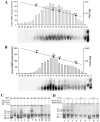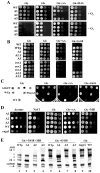Cellular Redox Metabolism Is Modulated by the Distinct Localization of Cyclic Nucleotide Phosphodiesterase 5A Isoforms
- PMID: 35955722
- PMCID: PMC9368758
- DOI: 10.3390/ijms23158587
Cellular Redox Metabolism Is Modulated by the Distinct Localization of Cyclic Nucleotide Phosphodiesterase 5A Isoforms
Abstract
3'-5' cyclic nucleotide phosphodiesterases (PDEs) are a family of evolutionarily conserved cAMP and/or cGMP hydrolyzing enzymes, components of transduction pathways regulating crucial aspects of cell life. Among them, cGMP-specific PDE5-being a regulator of vascular smooth muscle contraction-is the molecular target of several drugs used to treat erectile dysfunction and pulmonary hypertension. Production of full-length murine PDE5A isoforms in the milk-yeast Kluyveromyces lactis showed that the quaternary assembly of MmPDE5A1 is a mixture of dimers and tetramers, while MmPDE5A2 and MmPDE5A3 only assembled as dimers. We showed that the N-terminal peptide is responsible for the tetramer assembly of MmPDE5A1, while that of the MmPDE5A2 is responsible for its mitochondrial localization. Overexpression of the three isoforms alters at different levels the cAMP/cGMP equilibrium as well as the NAD(P)+/NAD(P)H balance and induces a metabolic switch from oxidative to fermentative. In particular, the mitochondrial localization of MmPDE5A2 unveiled the existence of a cAMP-cGMP signaling cascade in this organelle, for which we propose a metabolic model that could explain the role of PDE5 in some cardiomyopathies and some of the side effects of its inhibitors.
Keywords: Kluyveromyces lactis; cGMP-specific phosphodiesterase; glycolytic/respiratory flux; rag phenotype; redox balance.
Conflict of interest statement
The authors declare no conflict of interest.
Figures





Similar articles
-
Structural Characterization of Murine Phosphodiesterase 5 Isoforms and Involvement of Cysteine Residues in Supramolecular Assembly.Int J Mol Sci. 2023 Jan 6;24(2):1108. doi: 10.3390/ijms24021108. Int J Mol Sci. 2023. PMID: 36674621 Free PMC article.
-
The oligomeric assembly of the phosphodiesterase-5 is a mixture of dimers and tetramers: A putative role in the regulation of function.Biochim Biophys Acta Gen Subj. 2018 Oct;1862(10):2183-2190. doi: 10.1016/j.bbagen.2018.07.010. Epub 2018 Jul 17. Biochim Biophys Acta Gen Subj. 2018. PMID: 30025857
-
Use of the KlADH3 promoter for the quantitative production of the murine PDE5A isoforms in the yeast Kluyveromyces lactis.Microb Cell Fact. 2017 Sep 22;16(1):159. doi: 10.1186/s12934-017-0779-5. Microb Cell Fact. 2017. PMID: 28938916 Free PMC article.
-
Cyclic nucleotide phosphodiesterase-mediated integration of cGMP and cAMP signaling in cells of the cardiovascular system.Front Biosci. 2005 May 1;10:1221-8. doi: 10.2741/1614. Front Biosci. 2005. PMID: 15769620 Review.
-
Cardiac Phosphodiesterases and Their Modulation for Treating Heart Disease.Handb Exp Pharmacol. 2017;243:249-269. doi: 10.1007/164_2016_82. Handb Exp Pharmacol. 2017. PMID: 27787716 Free PMC article. Review.
Cited by
-
The rewiring of cAMP/cGMP and LDH signalling drives cardiac hypertrophy in Pde5a -/- mice.Life Sci Alliance. 2025 Jul 14;8(10):e202403094. doi: 10.26508/lsa.202403094. Print 2025 Oct. Life Sci Alliance. 2025. PMID: 40659490 Free PMC article.
-
Once upon a Testis: The Tale of Cyclic Nucleotide Phosphodiesterase in Testicular Cancers.Int J Mol Sci. 2023 Apr 20;24(8):7617. doi: 10.3390/ijms24087617. Int J Mol Sci. 2023. PMID: 37108780 Free PMC article. Review.
-
Phosphodiesterase 5a Signalling in Skeletal Muscle Pathophysiology.Int J Mol Sci. 2022 Dec 31;24(1):703. doi: 10.3390/ijms24010703. Int J Mol Sci. 2022. PMID: 36614143 Free PMC article.
-
Structural Characterization of Murine Phosphodiesterase 5 Isoforms and Involvement of Cysteine Residues in Supramolecular Assembly.Int J Mol Sci. 2023 Jan 6;24(2):1108. doi: 10.3390/ijms24021108. Int J Mol Sci. 2023. PMID: 36674621 Free PMC article.
References
-
- Beavo J.A., Conti M., Heaslip R.J. Multiple cyclic nucleotide phosphodiesterases. Mol. Pharmacol. 1994;46:399–405. - PubMed
-
- Keravis T., Lugnier C. Cyclic nucleotide phosphodiesterase (PDE) isozymes as targets of the intracellular signalling network: Benefits of PDE inhibitors in various diseases and perspectives for future therapeutic development. Br. J. Pharmacol. 2012;165:1288–1305. doi: 10.1111/j.1476-5381.2011.01729.x. - DOI - PMC - PubMed
MeSH terms
Substances
Grants and funding
LinkOut - more resources
Full Text Sources
Molecular Biology Databases

